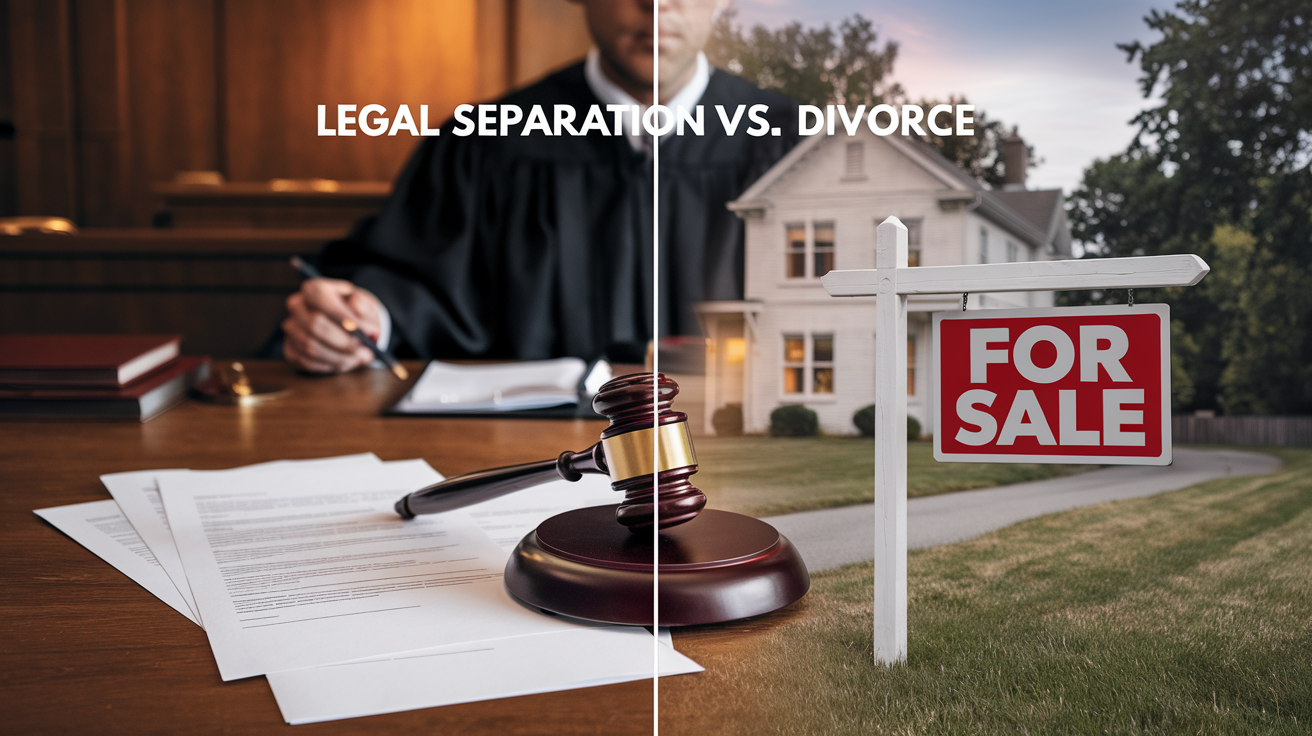
Legal Separation vs. Divorce: What’s the Difference in CA?
Are you standing at a crossroads in your marriage, unsure whether to choose legal separation or divorce? In California, these two paths may seem similar, but they have distinct implications that can significantly impact your future. Whether you’re grappling with religious beliefs, financial concerns, or need time to decide, understanding the nuances between legal separation and divorce is crucial.
Legal separation allows couples to formalize agreements without dissolving their marriage, while divorce marks the definitive end of a marital union. But did you know that in California, you don’t need to meet any residency requirements for legal separation, unlike divorce? This key difference, along with others, can profoundly affect your decision-making process. From maintaining health insurance benefits to navigating child custody arrangements, the choice between separation and divorce carries weight in various aspects of your life.
In this comprehensive guide, we’ll delve into the intricacies of legal separation and divorce in California. We’ll explore the reasons why couples might choose one over the other, examine the advantages and disadvantages of legal separation, and walk you through the legal processes involved. By the end, you’ll have a clearer understanding of which path might be right for you and your family. Let’s break down the complexities of these two legal options and help you make an informed decision.
Understanding Legal Separation in California

A. Definition and process of legal separation
Legal separation in California is a formal process that allows couples to remain married while addressing essential aspects of their relationship through a legal means. Unlike divorce, legal separation does not dissolve the marriage but provides a framework for couples to live apart and manage their affairs separately.
The process of legal separation in California involves filing a petition with the court. This petition can be based on two grounds: irreconcilable differences, which indicate a permanent breakdown of the marriage, or the rare condition of permanent legal incapacity to make decisions. Once the petition is filed, the court can issue orders regarding:
- Property division
- Debt responsibilities
- Spousal support (alimony)
- Child custody and visitation
- Child support
These orders are legally binding and enforceable, similar to those issued in a divorce proceeding. The legal separation process closely mirrors that of divorce, utilizing the same forms and procedures. However, couples can potentially achieve a Judgment of Legal Separation more quickly if they are in complete agreement on all issues.
B. Key differences from divorce
While legal separation and divorce share many similarities in terms of the issues addressed, there are several key differences:
- Marital status: In a legal separation, the couple remains legally married, but they are not living together. This means they cannot remarry or enter into a domestic partnership with another individual.
- Residency requirements: Unlike divorce, which requires one spouse to have lived in California for six months and in the filing county for three months, legal separation has no residency time requirement. Only one spouse needs to reside in California to file for legal separation.
- Waiting period: In California, divorce has a mandatory six-month waiting period after the divorce papers are served. Legal separation does not have this waiting period, potentially allowing for a quicker resolution.
- Benefits: Legally separated couples may retain certain benefits associated with marriage, such as health insurance coverage or tax advantages.
- Reconciliation: Couples who are legally separated have the option to reconcile without having to remarry. They can also convert their legal separation into a divorce if desired.
C. Requirements for filing legal separation
To file for legal separation in California, the following requirements must be met:
- Residency: At least one spouse must reside in California. There is no specific time requirement for residency in cases of legal separation.
- Grounds: The couple must cite either irreconcilable differences or permanent incapacity due to a legal reason as the reason for seeking legal separation.
- Agreement: While not strictly required, having an agreement on key issues such as property division, debt allocation, and child custody can expedite the legal separation process.
- Filing: The appropriate forms must be filed with the court, including the petition for legal separation and any accompanying documents detailing agreements or proposed arrangements.
- Service: The non-filing spouse must be properly served with the papers for legal separation.
It’s essential to note that for matters involving child custody or visitation, children must meet residency requirements for the court to have jurisdiction, except in cases of emergency.
With this understanding of legal separation in California, we can now explore the concept of divorce in the state. The following section, “Exploring Divorce in California,” delves into the specifics of dissolving a marriage, comparing it to legal separation in terms of process, requirements, and outcomes.
Exploring Divorce in California

Now that we’ve covered legal separation in California, let’s explore divorce in the state. While legal separation allows couples to live apart while remaining married, divorce is the legal dissolution of a marriage.
Definition and stages of divorce
Divorce in California is a structured process that consists of four key stages:
- Initiation: One spouse files the necessary papers, formally notifying the other spouse, who then has the opportunity to respond.
- Financial disclosure: Both parties are required to share relevant financial information, with the initial filer leading this exchange.
- Decision-making: Couples must make critical decisions regarding the division of property and debts, child custody, and any spousal or child support arrangements. These decisions can be mutually agreed upon or resolved through court intervention if necessary.
- Finalization: Once all matters are settled, the couple must submit the final paperwork to the court to officially finalize the divorce.
No-fault divorce system
California operates under a no-fault divorce system, which means that neither spouse needs to prove wrongdoing to initiate a divorce. The state recognizes “irreconcilable differences” as the primary grounds for divorce, which simplifies the process and reduces potential conflicts between parties.
Residency and waiting period requirements
To file for divorce in California, specific residency requirements must be met:
- At least one spouse must have resided in California for the last six months.
- The filing spouse must have lived in the respective county for the last three months.
It’s important to note that these requirements do not apply to a legal separation, which can be pursued immediately after one spouse moves to California. However, couples who initially file for legal separation can convert their case to a divorce once they meet the residency requirements.
Additional considerations for residency include:
- Same-sex couples can file for divorce in the county where they were married if they now reside in a jurisdiction that does not permit such actions.
- Domestic partners registered in California are exempt from residency requirements.
- Unregistered partnerships must adhere to the standard residency requirements.
Once the divorce process is initiated, a mandatory six-month waiting period must pass before the divorce can be finalized. This period begins on the date of filing the petition and serves as a cooling-off period, allowing couples to reconcile or finalize their arrangements, if they choose to do so.
The divorce process can be navigated without legal representation, but assistance is available through court Self-Help Centers for those who need guidance. For couples who have been married for less than five years and do not have children, a summary dissolution process offers a simplified alternative to the traditional divorce procedure.
With this understanding of divorce in California, we can now compare legal separation and divorce, which will help clarify the key differences between these two legal options for couples facing marital difficulties.
Comparing Legal Separation and Divorce

Now that we’ve explored divorce in California, let’s compare it with legal separation to understand the key differences and similarities between them.
Similarities in addressing marital issues
Both legal separation and divorce in California offer couples the opportunity to resolve critical marital issues. Whether you choose legal separation or divorce, you can establish legally binding agreements regarding:
- Property division
- Child support
- Custody and parenting time
- Spousal support
These agreements provide legal protection during the period of living apart, regardless of which option you choose. The process for initiating both legal separation and divorce is remarkably similar, using the same petition form and following comparable court procedures, including hearings and financial disclosures.
Differences in legal status and remarriage options
While legal separation and divorce share similarities in addressing marital issues, they differ significantly in terms of legal status:
- Marital status: Legal separation allows couples to resolve matters while remaining legally married. In contrast, divorce completely terminates the marriage status.
- Remarriage: Legally separated individuals cannot remarry without first obtaining a divorce. Divorced individuals, however, are free to remarry once the divorce is finalized.
- Cooling-off period: In California, divorce requires a mandatory six-month waiting period after filing before the marital status can be terminated. Legal separation does not have this requirement and can be finalized more quickly if an agreement is reached.
- Residency requirements: Unlike divorce, which requires at least one spouse to have lived in California for six months and in the relevant county for three months before filing, legal separation has no residency duration requirement.
Financial implications and benefits
The choice between legal separation and divorce can have significant financial implications:
- Tax filing: Legally separated couples can still file taxes jointly, while divorced individuals are required to file separately.
- Social Security benefits: Divorced individuals may be eligible for certain Social Security benefits after a certain number of years of marriage, although legal separation can complicate these benefits.
- Health insurance: Legal separation may allow one spouse to maintain health insurance coverage through the other’s plan, whereas divorce typically terminates this benefit.
- Financial accounts: In a divorce, beneficiary designations for financial accounts are typically revoked, whereas they may remain intact during a legal separation.
- Property division: Both processes allow for the division of assets and debts, but the finality of divorce may provide more clarity in financial matters.
It’s important to note that while legal separation is often pursued for reasons such as religious beliefs or healthcare coverage, the actual benefits may be limited. The choice between legal separation and divorce depends on individual circumstances, financial considerations, and personal readiness for a permanent change in marital status.
With this understanding of the similarities and differences between legal separation and divorce, we’ll next explore the specific reasons why couples might choose legal separation over divorce in California.
Reasons to Choose Legal Separation

Now that we’ve compared legal separation and divorce in California, let’s explore the reasons why some couples choose legal separation over divorce. Understanding these motivations can help individuals make informed decisions about their marital status.
Religious or personal beliefs
Many couples opt for legal separation due to their religious or personal convictions. Some religions frown upon or prohibit divorce, making legal separation a viable alternative for those who wish to live apart while maintaining their marital status. This option allows individuals to honor their faith or personal beliefs without having to dissolve their marriage completely.
Legal separation provides a court-sanctioned means for couples to live separately while remaining married. This arrangement can be particularly appealing to those who have strong personal convictions against divorce but still need to address important matters such as property division and child custody.
Maintaining certain benefits (e.g., health insurance)
One of the significant advantages of legal separation is the ability to retain certain marital benefits. This is often a crucial factor for couples considering their options. Some of the benefits that can be maintained through legal separation include:
- Health insurance coverage: Many individuals can continue to receive health insurance through their spouse’s employer-sponsored plan during a legal separation.
- Military benefits: Couples may choose legal separation to preserve military benefits for the non-service member spouse.
- Social Security benefits: In some cases, legal separation allows spouses to continue receiving Social Security benefits based on their partner’s work history.
- Retirement benefits: Legal separation may allow couples to maintain certain retirement benefits that would otherwise be lost in a divorce.
By choosing legal separation, couples can protect these significant financial and health-related benefits while living apart and pursuing separate lives.
Trial period for resolving marital issues
Legal separation can serve as a preliminary step for couples who are unsure about permanently ending their marriage. This option provides a structured environment for managing finances and custody issues without the finality of divorce. Some couples view legal separation as a trial period, allowing them time to:
- Reflect on their relationship: Legal separation gives partners space to evaluate their feelings and the state of their marriage without the pressure of an immediate divorce.
- Attempt reconciliation: Unlike divorce, legal separation can be reversed if the couple decides to reconcile, providing an opportunity to work on their relationship.
- Address marital problems: The separation period allows couples to focus on resolving conflicts and improving communication without the stress of living together.
- Prepare for potential divorce: If reconciliation is not possible, legal separation can help couples transition more smoothly into divorce proceedings.
Additionally, legal separation can be advantageous for couples who do not yet meet California’s residency requirements for filing for divorce. While divorce in California requires one spouse to have lived in the state for six months and in the filing county for three months, legal separation has no such time requirement. This makes it a suitable option for those who need to address their marital issues promptly but cannot yet file for divorce.
As we move forward to discuss the advantages of legal separation, it’s essential to note that while these reasons may make legal separation an attractive option for some couples, it’s crucial to consider all aspects of this decision carefully. Legal separation comes with its own set of benefits and drawbacks, which we’ll explore in the next section.
Advantages of Legal Separation

Now that we’ve explored the reasons to choose legal separation, let’s delve into the advantages this option offers in California. Legal separation provides several benefits that may make it a preferable option for some couples compared to divorce.
No residency requirements
One significant advantage of legal separation in California is the absence of residency requirements. Unlike divorce, which typically requires at least one spouse to have resided in the state for a minimum period, legal separation can be pursued immediately. This flexibility allows couples to address their marital issues promptly, regardless of how long they’ve lived in California.
Faster resolution process
Legal separation often offers a quicker resolution compared to divorce proceedings. Since the process doesn’t involve the complete dissolution of marriage, it can be less complex and time-consuming. Couples may find it easier to reach agreements on crucial matters such as asset division, child custody, and support arrangements. This expedited process can provide much-needed stability and clarity for both parties and their children during a challenging time.
Easier reconciliation options
Perhaps one of the most compelling advantages of legal separation is the increased potential for reconciliation. By maintaining the marital bond, couples have the opportunity to reflect on their relationship without the finality of divorce. This arrangement allows spouses to:
- Process their feelings and seek professional help without the pressures of finalizing a divorce
- Evaluate their long-term options while maintaining financial security
- Work through conflicts while upholding your marital commitments, especially if you have religious or ethical beliefs that discourage divorce.
The structure provided by legal separation enables couples to address their issues while keeping the door open for potential reconciliation. If they decide to reunite, the process is generally more straightforward than remarrying after a divorce.
Additionally, legal separation offers other financial benefits that can make reconciliation more feasible:
- Continued access to certain financial benefits, such as health insurance coverage under a spouse’s plan
- The ability to file joint tax returns, potentially resulting in tax advantages
- Preservation of property rights and inheritance rights
These financial considerations can provide a more stable foundation for couples considering reconciliation, allowing them to focus on rebuilding their relationship without immediate financial pressures.
It’s important to note that while legal separation offers these advantages, it also comes with its own set of challenges. With this in mind, we will next explore the disadvantages of legal separation to provide a comprehensive understanding of this legal option in California.
Disadvantages of Legal Separation

Now that we’ve explored the advantages of legal separation, it’s essential to consider the potential drawbacks. While legal separation can offer certain benefits, it also comes with its own set of challenges that couples should carefully consider before making a decision.
A. Inability to remarry
One of the most significant disadvantages of legal separation in California is that it does not allow either party to remarry. Unlike divorce, which ends the marriage, legal separation preserves the marital bond. This means that even though couples are living apart and may have separate lives, they are still legally married to each other. For individuals who may wish to pursue new relationships or potentially remarry in the future, this limitation can be a significant drawback. It’s crucial to understand that if remarriage is a consideration, legal separation may not be the best option, and divorce might be a more suitable choice.
B. Continued tax implications
Another critical aspect to consider is the ongoing tax implications that come with legal separation. While legal separation can offer some financial protections, it does not completely sever the financial ties between spouses. This means that specific tax considerations that apply to married couples may still be relevant during a legal separation. For instance, couples who are legally separated may still be responsible for each other’s debts or financial obligations. Additionally, if one spouse incurs new debts during the separation, the other spouse could potentially be held liable. This continued financial entanglement can complicate matters and may not provide the clean break that some individuals seek when considering separation or divorce.
C. Potential complications with health insurance
While legal separation can sometimes allow spouses to retain certain benefits, such as health insurance, it’s essential to note that this is not always guaranteed. In some cases, legal separation may lead to complications with health insurance coverage. Some insurance providers may view a legal separation similarly to divorce and may terminate coverage for the spouse who is separated. This can be a significant concern, especially for individuals who rely on their spouse’s health insurance for medical coverage. It’s crucial for couples considering legal separation to carefully review their health insurance policies and understand how a separation might impact their coverage.
Furthermore, the continued financial ties between legally separated spouses can also extend to other areas. For example, if one spouse passes away during the legal separation, the other may still have claims on their estate or retirement funds. This is in contrast to divorce, where such claims would typically be terminated. Additionally, shared bank accounts and credit cards may continue during a legal separation, potentially resulting in shared debts that could negatively impact one’s credit score.
It’s also worth noting that while legal separation can offer some protection from new debts incurred by a spouse, it requires proactive measures to define property division and support responsibilities. Without clear boundaries and agreements in place, legal separation can lead to ongoing financial entanglements and potential conflicts.
With these disadvantages in mind, it is clear that the decision between legal separation and divorce is a deeply personal one and requires careful consideration. Couples must weigh the potential drawbacks against the advantages and consider their individual circumstances, beliefs, and long-term goals.
As we move forward to discuss the legal process and considerations involved in both legal separation and divorce, it’s important to remember that each option has its own set of pros and cons. Understanding these factors is crucial in making an informed decision about the best course of action for your specific situation.
Legal Process and Considerations

Now that we’ve explored the disadvantages of legal separation, let’s delve into the legal process and considerations for both separation and divorce in California.
Filing procedures for separation and divorce
The filing procedures for legal separation and divorce in California share many similarities. Both processes begin with fulfilling residency requirements. At least one spouse must have lived in the state for six months to a year to establish court jurisdiction. This is crucial, as failure to meet these requirements can result in the petition being dismissed.
For both legal separation and divorce, the process starts with drafting a petition. This document must clearly articulate the grounds for separation or divorce, typically citing no-fault reasons such as irreconcilable differences. The petition should also include detailed accounts of property and assets, distinguishing between marital and separate property. If children are involved, arrangements for custody, visitation, and support must be outlined, always prioritizing the child’s best interests.
Once the petition is complete, it must be filed with the appropriate court. Accuracy is paramount to avoid delays. After filing, the documents must be served to the other spouse, usually through personal service. In some cases, alternative methods of service may be approved if necessary.
Timeline differences between separation and divorce
While the initial steps for legal separation and divorce are similar, the timeline can differ significantly. Legal separation generally moves more quickly through the court system compared to divorce. This is because legal separation does not dissolve the marriage, which simplifies some aspects of the process.
In contrast, divorce in California has a mandatory six-month waiting period from the date of filing before it can be finalized. This cooling-off period is designed to allow couples time for potential reconciliation or to fully consider the implications of ending their marriage.
During both separation and divorce proceedings, parties may seek temporary relief for urgent matters such as spousal support or child custody. This involves filing a motion and may result in expedited hearings, potentially affecting the overall timeline.
Importance of legal counsel in decision-making
Given the complexities of California family law, seeking legal counsel is crucial when deciding between legal separation and divorce. An experienced attorney can provide invaluable guidance on the specific implications of each option.
Legal counsel can help navigate the mediation and alternative dispute resolution (ADR) processes, which are often encouraged in both separation and divorce cases. Mediation involves a neutral third party guiding negotiations, while other ADR options, such as collaborative law and arbitration, provide additional avenues for resolving disputes amicably.
An attorney can also represent your interests during court hearings, which are conducted to resolve contested issues or formalize agreements. Judges oversee these hearings and play a crucial role in determining the outcome of your case.
Moreover, legal counsel can help ensure that the final separation order or divorce decree accurately reflects the terms agreed upon or decided by the court. This includes provisions for asset division, custody arrangements, and any other relevant matters.
In conclusion, while legal separation and divorce share many procedural similarities, it is essential to understand the nuances of each process. The timeline differences and the finality of divorce versus the potential for reconciliation in legal separation are crucial factors to consider. Regardless of which path you choose, seeking expert legal counsel can significantly impact the outcome and help protect your interests throughout the process.

Legal separation and divorce in California offer distinct paths for couples facing marital challenges. While both processes address crucial matters like property division, child custody, and financial support, they differ significantly in their outcomes. Legal separation allows couples to remain married while living apart, maintaining certain benefits and leaving the door open for reconciliation. On the other hand, divorce permanently dissolves the marriage, offering a clean break and the freedom to remarry.
The choice between legal separation and divorce depends on individual circumstances, including religious beliefs, financial considerations, and personal readiness for a permanent change. It’s essential to note that legal separation can be a stepping stone to divorce or a long-term arrangement in its own right. Regardless of the chosen path, seeking guidance from a knowledgeable family law attorney is crucial for navigating the complex legal landscape and protecting one’s rights and interests. By understanding the nuances of both options, couples can make informed decisions that best suit their unique situations and future goals.










